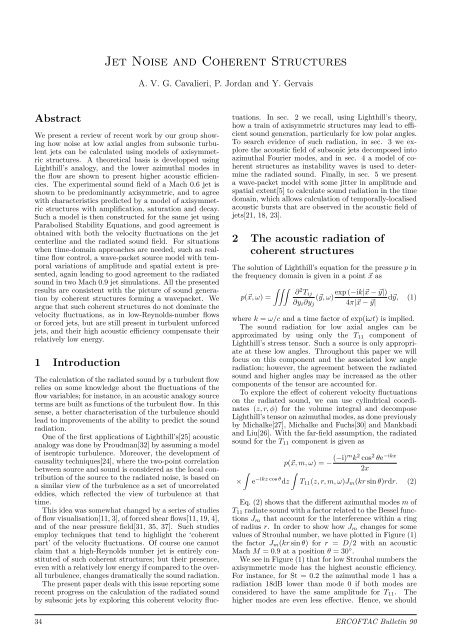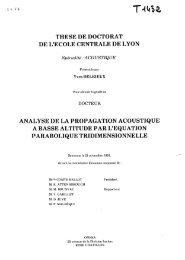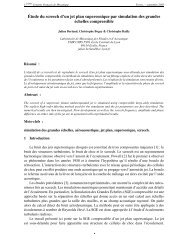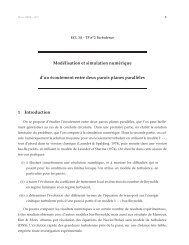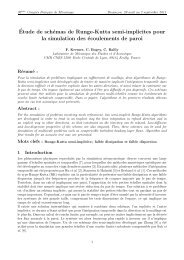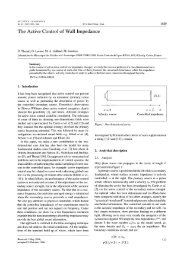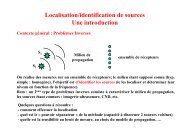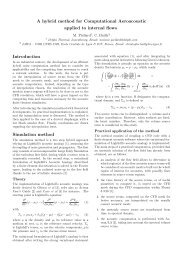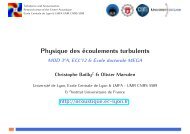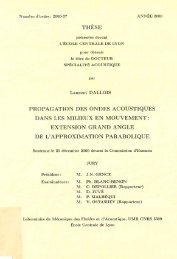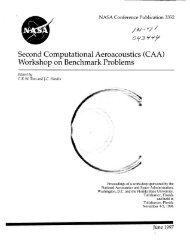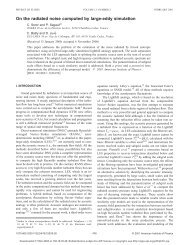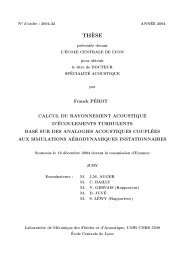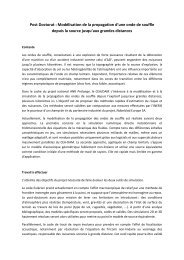ERCOFTAC Bulletin - Centre Acoustique
ERCOFTAC Bulletin - Centre Acoustique
ERCOFTAC Bulletin - Centre Acoustique
You also want an ePaper? Increase the reach of your titles
YUMPU automatically turns print PDFs into web optimized ePapers that Google loves.
Abstract<br />
Jet Noise and Coherent Structures<br />
We present a review of recent work by our group showing<br />
how noise at low axial angles from subsonic turbulent<br />
jets can be calculated using models of axisymmetric<br />
structures. A theoretical basis is developped using<br />
Lighthill’s analogy, and the lower azimuthal modes in<br />
the flow are shown to present higher acoustic efficiencies.<br />
The experimental sound field of a Mach 0.6 jet is<br />
shown to be predominantly axisymmetric, and to agree<br />
with characteristics predicted by a model of axisymmetric<br />
structures with amplification, saturation and decay.<br />
Such a model is then constructed for the same jet using<br />
Parabolised Stability Equations, and good agreement is<br />
obtained with both the velocity fluctuations on the jet<br />
centerline and the radiated sound field. For situations<br />
when time-domain approaches are needed, such as realtime<br />
flow control, a wave-packet source model with temporal<br />
variations of amplitude and spatial extent is presented,<br />
again leading to good agreement to the radiated<br />
sound in two Mach 0.9 jet simulations. All the presented<br />
results are consistent with the picture of sound generation<br />
by coherent structures forming a wavepacket. We<br />
argue that such coherent structures do not dominate the<br />
velocity fluctuations, as in low-Reynolds-number flows<br />
or forced jets, but are still present in turbulent unforced<br />
jets, and their high acoustic efficiency compensate their<br />
relatively low energy.<br />
1 Introduction<br />
The calculation of the radiated sound by a turbulent flow<br />
relies on some knowledge about the fluctuations of the<br />
flow variables; for instance, in an acoustic analogy source<br />
terms are built as functions of the turbulent flow. In this<br />
sense, a better characterisation of the turbulence should<br />
lead to improvements of the ability to predict the sound<br />
radiation.<br />
One of the first applications of Lighthill’s[25] acoustic<br />
analogy was done by Proudman[32] by assuming a model<br />
of isentropic turbulence. Moreover, the development of<br />
causality techniques[24], where the two-point correlation<br />
between source and sound is considered as the local contribution<br />
of the source to the radiated noise, is based on<br />
a similar view of the turbulence as a set of uncorrelated<br />
eddies, which reflected the view of turbulence at that<br />
time.<br />
This idea was somewhat changed by a series of studies<br />
of flow visualisation[11, 3], of forced shear flows[11, 19, 4],<br />
and of the near pressure field[31, 35, 37]. Such studies<br />
employ techniques that tend to highlight the ‘coherent<br />
part’ of the velocity fluctuations. Of course one cannot<br />
claim that a high-Reynolds number jet is entirely constituted<br />
of such coherent structures; but their presence,<br />
even with a relatively low energy if compared to the overall<br />
turbulence, changes dramatically the sound radiation.<br />
The present paper deals with this issue reporting some<br />
recent progress on the calculation of the radiated sound<br />
by subsonic jets by exploring this coherent velocity fluc-<br />
A. V. G. Cavalieri, P. Jordan and Y. Gervais<br />
tuations. In sec. 2 we recall, using Lighthill’s theory,<br />
how a train of axisymmetric structures may lead to efficient<br />
sound generation, particularly for low polar angles.<br />
To search evidence of such radiation, in sec. 3 we explore<br />
the acoustic field of subsonic jets decomposed into<br />
azimuthal Fourier modes, and in sec. 4 a model of coherent<br />
structures as instability waves is used to determine<br />
the radiated sound. Finally, in sec. 5 we present<br />
a wave-packet model with some jitter in amplitude and<br />
spatial extent[5] to calculate sound radiation in the time<br />
domain, which allows calculation of temporally-localised<br />
acoustic bursts that are observed in the acoustic field of<br />
jets[21, 18, 23].<br />
2 The acoustic radiation of<br />
coherent structures<br />
The solution of Lighthill’s equation for the pressure p in<br />
the frequency domain is given in a point x as<br />
p(x, ω) =<br />
∂ 2 Tij<br />
exp (−ik|x − y|)<br />
(y, ω) dy, (1)<br />
∂yi∂yj 4π|x − y|<br />
where k = ω/c and a time factor of exp(iωt) is implied.<br />
The sound radiation for low axial angles can be<br />
approximated by using only the T11 component of<br />
Lighthill’s stress tensor. Such a source is only appropriate<br />
at these low angles. Throughout this paper we will<br />
focus on this component and the associated low angle<br />
radiation; however, the agreement between the radiated<br />
sound and higher angles may be increased as the other<br />
components of the tensor are accounted for.<br />
To explore the effect of coherent velocity fluctuations<br />
on the radiated sound, we can use cylindrical coordinates<br />
(z, r, φ) for the volume integral and decompose<br />
Lighthill’s tensor on azimuthal modes, as done previously<br />
by Michalke[27], Michalke and Fuchs[30] and Mankbadi<br />
and Liu[26]. With the far-field assumption, the radiated<br />
sound for the T11 component is given as<br />
<br />
×<br />
e −ikz cos θ dz<br />
p(x, m, ω) = − (−i)mk2 cos2 θe−ikx <br />
2x<br />
T11(z, r, m, ω)Jm(kr sin θ)rdr. (2)<br />
Eq. (2) shows that the different azimuthal modes m of<br />
T11 radiate sound with a factor related to the Bessel functions<br />
Jm that account for the interference within a ring<br />
of radius r. In order to show how Jm changes for some<br />
values of Strouhal number, we have plotted in Figure (1)<br />
the factor Jm(kr sin θ) for r = D/2 with an acoustic<br />
Mach M = 0.9 at a position θ = 30 ◦ .<br />
We see in Figure (1) that for low Strouhal numbers the<br />
axisymmetric mode has the highest acoustic efficiency.<br />
For instance, for St = 0.2 the azimuthal mode 1 has a<br />
radiation 18dB lower than mode 0 if both modes are<br />
considered to have the same amplitude for T11. The<br />
higher modes are even less effective. Hence, we should<br />
34 <strong>ERCOFTAC</strong> <strong>Bulletin</strong> 90


